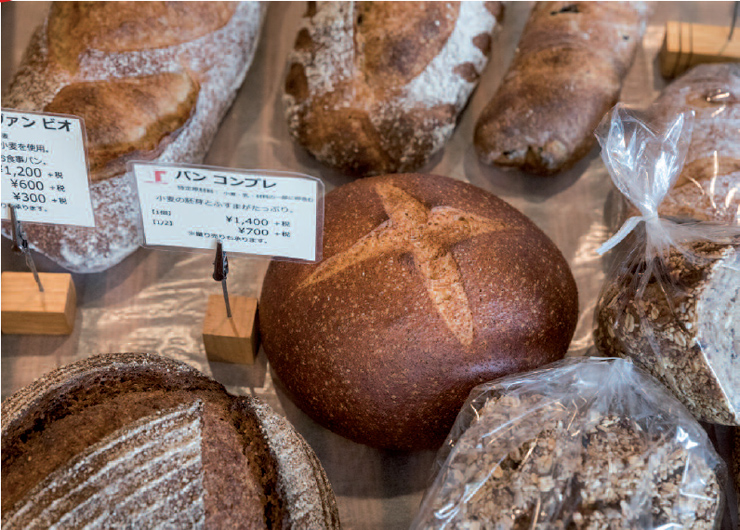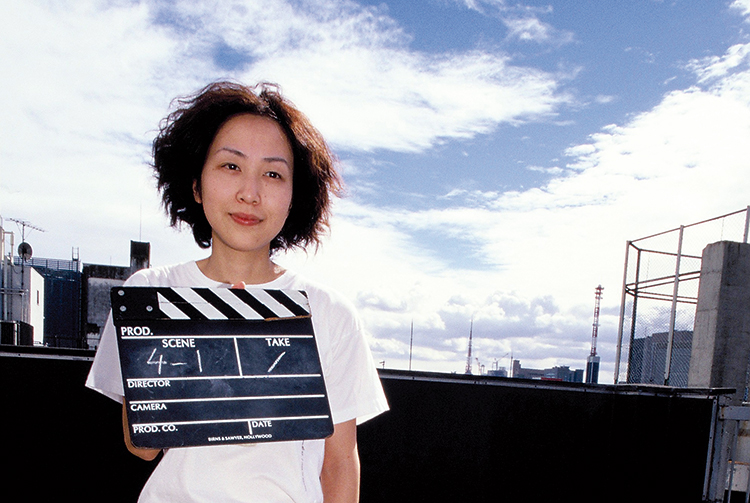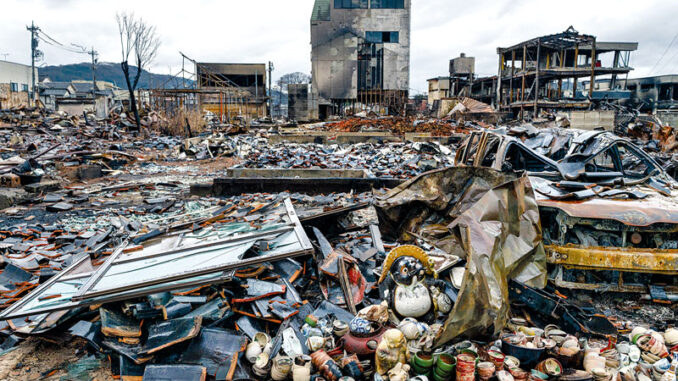
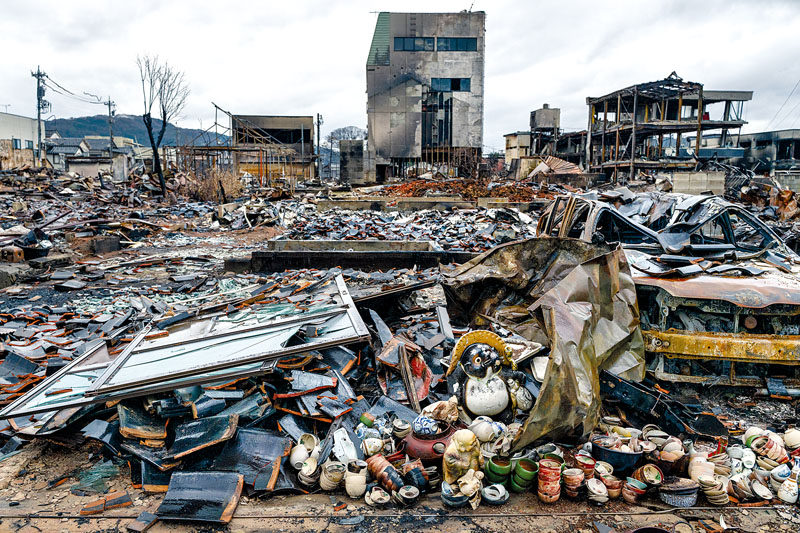
Heading north down the mountain towards the Sea of Japan, you reach Wajima and gradually discover the extent of the destruction on the plain. On the outskirts of the city, an entire side of the mountain has collapsed, causing a massive landslide that seems to have swallowed an entire hamlet. As you approach along the road, the number of houses in ruins increases, some of them even seem to have tumbled down from the hillside. The wide avenue leading into town, lined with a succession of lacquerware shops, is deserted; all the shops are closed, many severely damaged by the tremors. On reaching the city centre, countless buildings have been completely destroyed. A seven-storey building lies horizontally at the side of a crossroads, and manhole covers appear to have emerged from the cracks in the roads like mushrooms after it has rained.
The fires that broke out after the violent tremors spread rapidly, devastating Wajima’s famous market located in the heart of the lacquerware manufacturing district, reducing over 200 shops and homes to ashes. Confronted with this scene of destruction, the carcasses of burnt-out cars and buildings, one realizes the extent of the disaster for the municipality. The centre of Wajima resembles the devastated landscape of Tokyo after the fires caused by the Great Kanto Earthquake in 1923.
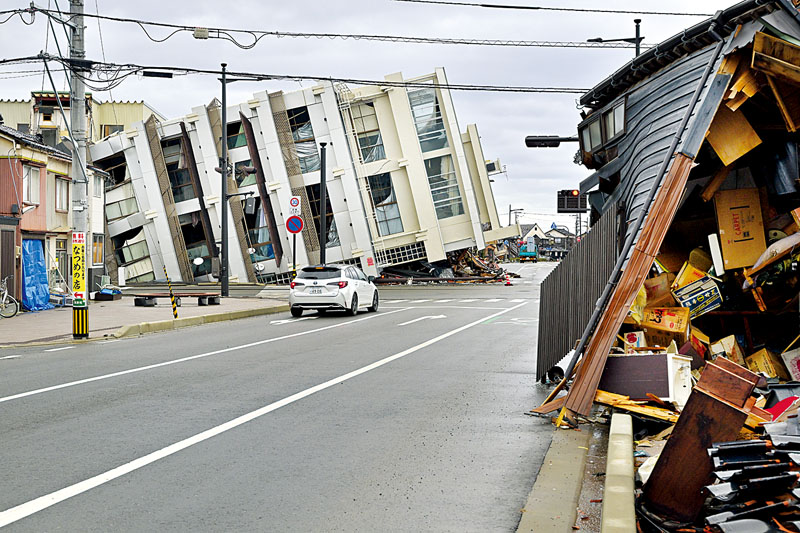
Three weeks after the earthquake, the atmosphere in the town is grim; the few residents still going about their daily activities creep through the ruins. Mrs Furuhata is returning from the Genki supermarket, which has just reopened. “They finally have vegetables.That’s a change from instant noodles,” she says quietly as she enters her modest house, which has surprisingly remained standing, while those of her neighbours lie in ruins. On the front door is a red notice. “Kiken-Unsafe, entering this building is dangerous,” states the authorities’ message. “No, it’s okay, it’s just the back of the house that collapsed,” she reassures us. Like her, many of the survivors choose to continue living in their homes, even if they have been damaged, rather than go to an evacuation centre. An employee at a retirement home outside the town, she was working over New Year and recounts, still in shock, how the worst part was not knowing for over two days whether her daughter and mother had survived or not. “It’s thanks to my daughter that my mother is still alive,” she says with tears in her eyes. Across the town, numerous groups of technicians from all over the country are busy. Whether employees from the Tokyo Water Department or electricians from Oita Prefecture, on Kyushu Island, their task seems endless.
Obanayama Tetsuo, owner of the tonkatsu (breaded, deep-fried pork cutlets) and seafood restaurant Saika-tei, stands out from the general gloom. His establishment, located right on the edge of the market devastated by the fire, is miraculously intact, spared from the flames and tremors. He points to the tall trees that separate his house from the ruins of the fire. “These trees, you see, they’re sudajii (Castanopsis sieboldii), which are pretty fire-resistant. They saved my restaurant!” he asserts. He was at an onsen (hot spring) with his family to celebrate New Year and on his return discovered the town in ruins, but his restaurant unscathed. Although he lost three neighbours who perished in the fire, he remains optimistic. “In two years, the town will be able to recover,” he says.
A few steps from the Goshimaya store, which has been producing and selling Wajima lacquerware since 1924 and whose seven-storey building collapsed like a house of cards, Yoshida Kiyoe, a 35-year-old woman, is cleaning the Hair Chic hair salon, which she manages, with a friend of the same age. Although her shop has hardly suffered any damage from the disaster, she wonders about the future of the town. “My friends have already started to leave, and I’m wondering if I should do the same,” she confides. “The population will most likely decrease by half. It’s been said that the number of inhabitants in Wajima would fall from 20,000 to 10,000 by 2050, but this is likely to happen as early as this year. Young people are going to leave to start a new life elsewhere,” she asserts, as her friend looks on in agreement.
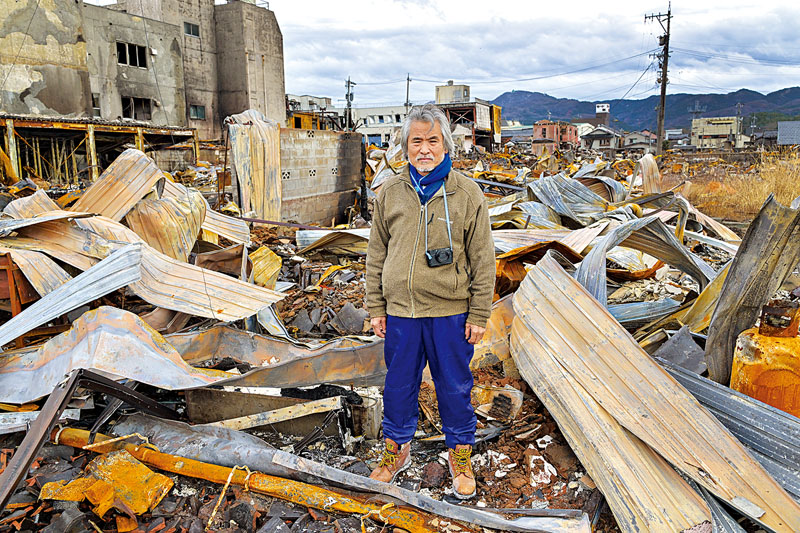
In one of the alleyways leading to the port, a small group of elderly men are smoking cigarettes while queuing up outside the French food restaurant, L’Atelier de Noto, which has been turned into a soup kitchen in the aftermath of the disaster and is preparing meals for the victims. “The best food in Wajima,” they assure us. One of them, Yoshimura Sho, has come from Anamizu, a small town nearby in the south of the peninsula, to take care of his very elderly mother who is struggling to adapt to the difficult living conditions. A month after the earthquake, the town is still completely without running water. He comes to the Atelier every day to pick up two hot meals and hasn’t a kind word for the government. “All the state’s money will go to the Osaka World Expo [opening in spring 2025], we can’t expect anything from the authorities, we can only rely on ourselves to rebuild the region,” he declares bitterly. “But it’s human nature to rebuild. So we’ll get to work, and besides, in Japan, we have to live with earthquakes,” he continues. One of his neighbours in the queue adds another thought. “After the 2007 earthquake, we all felt the worst was behind us and we allowed ourselves to believe that there would never be another major earthquake,” he recalls. And what about the intense seismic activity on the peninsula since 2020? “Not a single Japanese person will tell you they expected such a disaster!” he concludes.
A few blocks away, Sakashita Masato, 50 years old, disagrees. “As the the ground has been continually shaking in Noto for the past three years, I was certain that a big earthquake was going to happen,” he says. “Just maybe not on New Year’s Day!” he adds, laughing. A house painter, he no longer has a home or a job, and recounts the terror at New Year when his house collapsed on his family who had gathered for the holidays. Luckily, they all managed to get out including their two cats and rushed to get into the car as tsunami warnings sounded. “We found ourselves stuck in a traffic jam with everyone heading towards the mountains,” he recalls. “From the higher ground, we could see the city burning in the darkness.” He spent the first few nights after the disaster in his car with his wife and their cats. Today, housed in an evacuation centre, he has filed a request for a temporary prefabricated home, of which hundreds are supposed to be built, and spends his free time with his wife distributing goods, which have been sent in large quantities from all over Japan, to other victims. That day, it was pet food. Only one thing is still really missing: large blue plastic tarpaulins, ubiquitous in Japan, which are being used in Noto to cover roofs and tombstones damaged by the earthquake.
Within the precincts of Juzo Shrine, most of whose buildings, still decorated with pine and bamboo for New Year, have been destroyed, an association of restaurateurs from Osaka has set up white tents in which young men are busily preparing yakisoba (stir fried) noodles and other Kansai-style dishes. About a hundred people are queuing in the freezing cold. “Food is distributed almost daily,” explains a young boy in the queue. And waving his phone, he adds, “You just have to search.” He was informed about that day’s distribution on the shrine’s Instagram account.
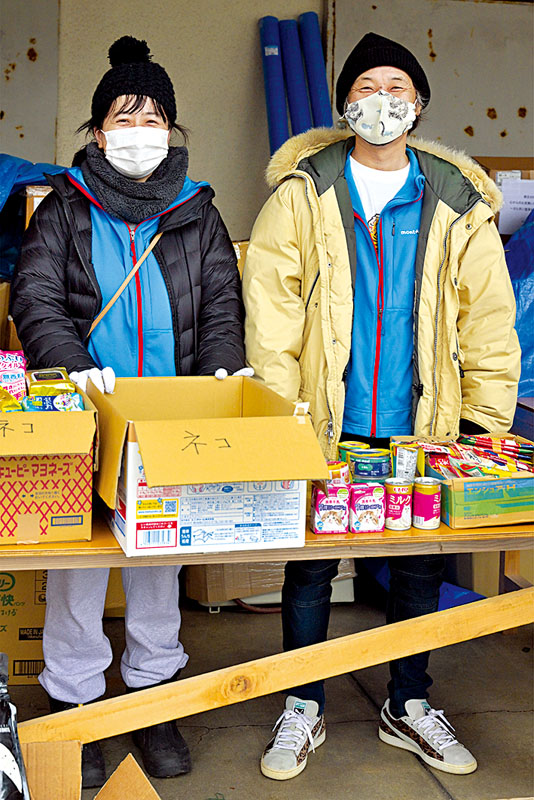
In the midst of the ruins of Wajima Market, a man with grey hair appears to be examining the rubble, and with a small camera hanging around his neck on a string, is taking photos of the sheets of metal twisted by the violence of the fire, the scattered traces of life. “Are you searching for beauty amongst these ruins?” someone ventures as they approach him. He stops, surprised, and replies, “That’s exactly it! But I daren’t say that; people wouldn’t understand.” Hamaguchi Yukio, a retired art history professor, lives just across the river running alongside the market to the sea. He explains that since the big fire, he has taken over 2000 photographs of the market, trying to make sense of the desolation. He recalls the centuries-old history of the refined lacquerware of Wajima and laments that such a precious tradition has gone up in smoke. But pointing to the many burnt-out carcasses of cars, the countless scattered objects, he explains that the challenge of reconstruction should be an opportunity to question the priorities that modernity has presented us. “Material comfort, getting rich at any cost and the accumulation of consumer goods has overridden the pursuit of beauty and perfection, which prevailed among artisans of the past,” he explains. “Look at these houses, they collapsed under the weight of their imposing roofs, which were also a sign of social status.” “In Japan, the convenience of daily life takes precedence over everything. So, we must rebuild, but differently, by returning to our origins, by questioning what the priorities of our existence should be,” he adds.
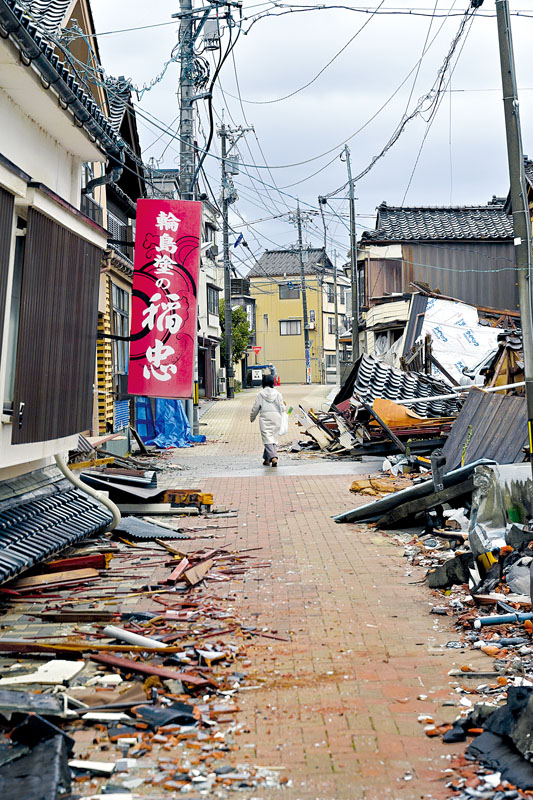
In the midst of the market’s ruins, in an area prohibited to the public, a small group of young people, a girl and four boys, are walking around. They have come specially from the suburbs of Tokyo “to see”. They take selfies in front of the burnt-out cars, and you begin to doubt whether the wise advice of Professor Hamaguchi will ever be heeded.
Eric Rechsteiner
To learn more on this topic, check out our other articles :
N°139 [FOCUS] 1 January, Noto Peninsula
N°139 [FOCUS] TOME – A tragedy for rice farming
N°139 [FOCUS] SHIKA – In the shadow of the nuclear power plant
N°139 [TRAVEL] Osore-zan, a foretaste of hell
Follow us !


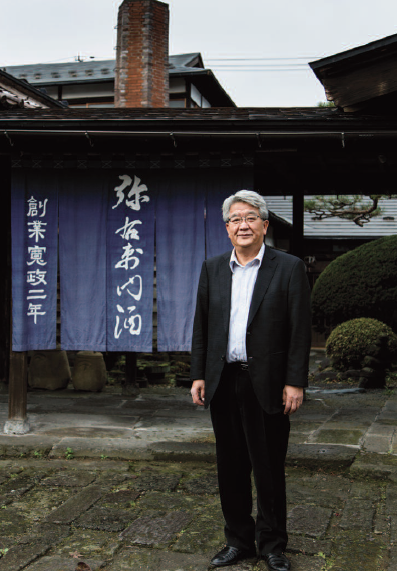
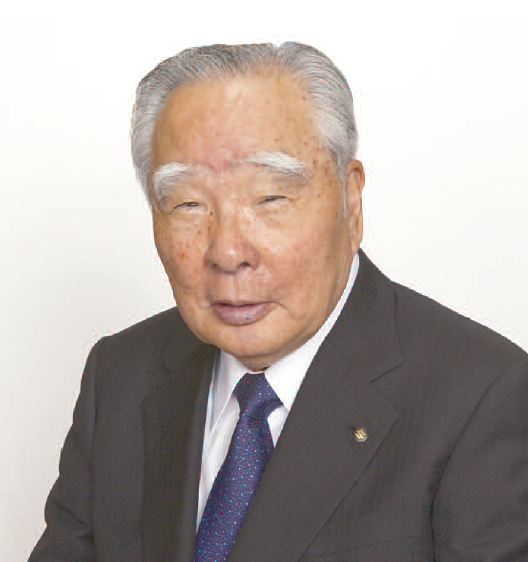
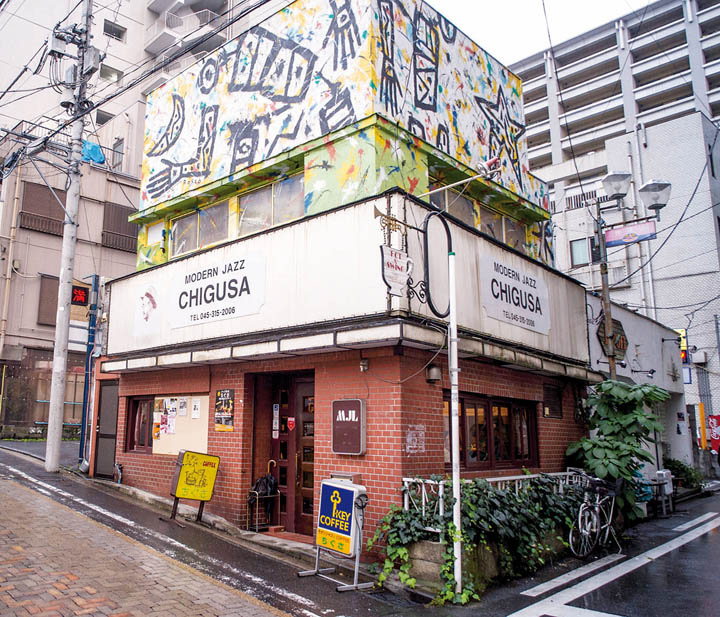
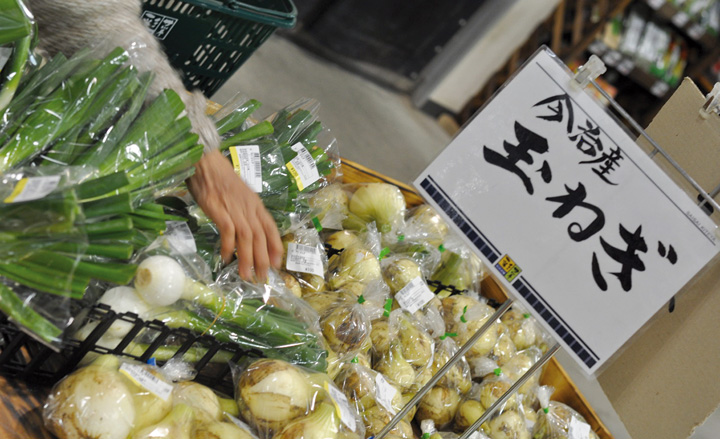
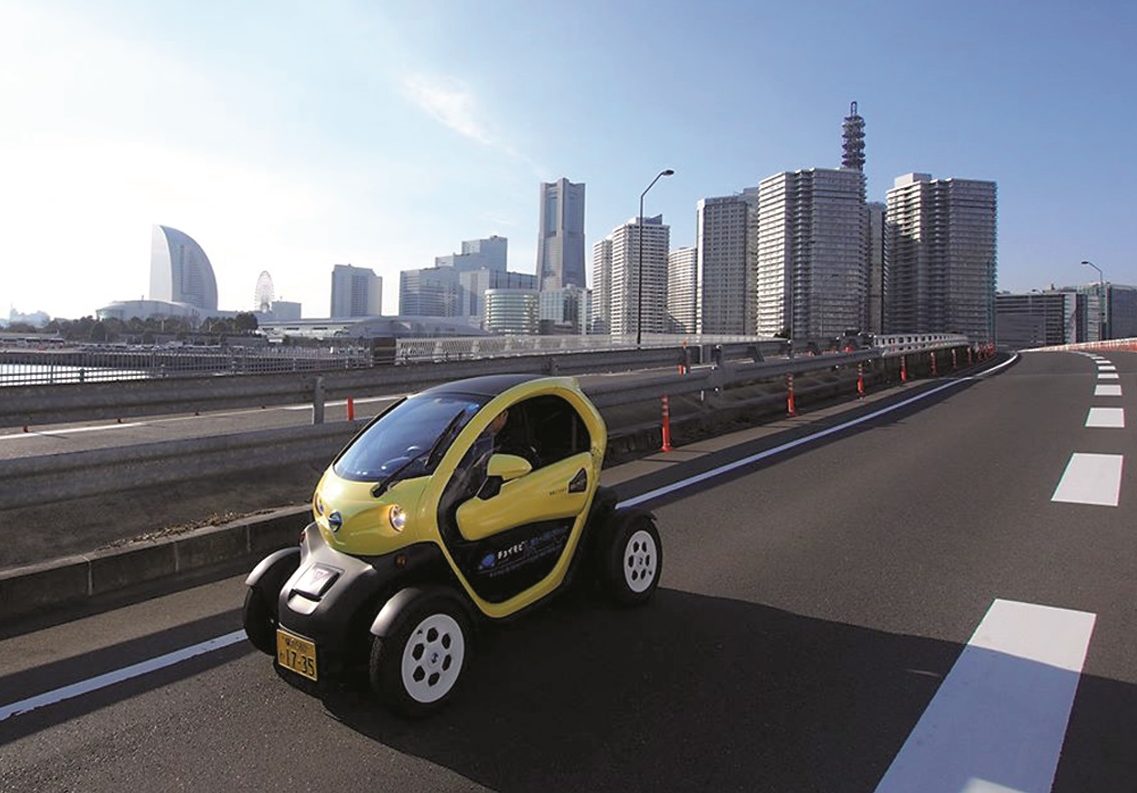
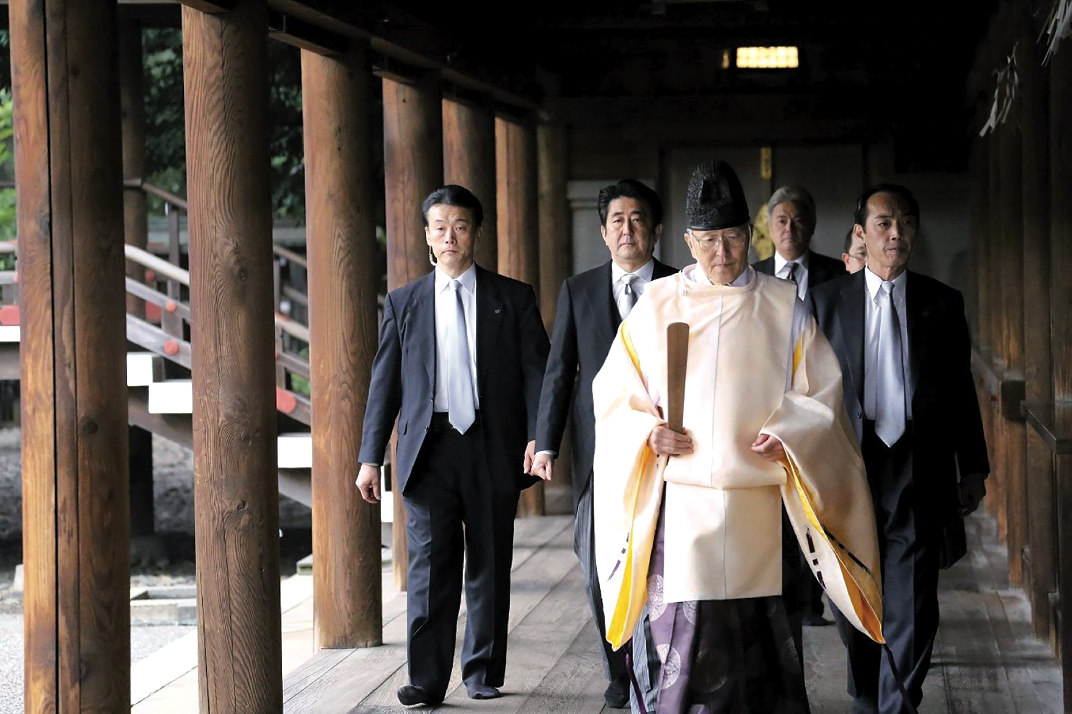
![No51 [MEMORY] A writer who cannot forget](https://www.zoomjapan.info/wp/wp-content/uploads/focus02.png)
